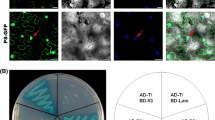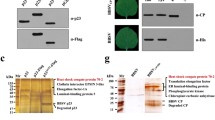Abstract
Rice stripe tenuivirus (RSV) is mainly transmitted by the insect vector small brown planthopper (SBPH, Laodelphax striatellus) in a persistent-propagative manner. Virus transmission is dependent on the interplay between viral proteins and vector factors. Pc2, a nonstructural protein of RSV, plays an important role in virus transmission. However, the vector proteins that interact with Pc2 are unknown. In this study, we identified three SBPH proteins that interact with the N-terminal 381 amino acids of Pc2 (Pc2N) by using a yeast two-hybrid system (Y2H). The interaction of Pc2N with heat shock protein cognate 70 (HSC70) was studied further. HSC70 was verified to interact with RSV Pc2N by biomolecular fluorescence complementation and co-immunoprecipitation assays. HSC70 colocalized with RSV Pc2N in both Sf9 cells and the hemocytes of SBPHs. Inhibition of HSC70 expression via RNA interference reduced virus levels in hemolymph and salivary glands of SBPHs and resulted in decreased virus transmission efficiency. These data provide evidence that a vector protein, HSC70, is employed by RSV to facilitate virus accumulation in the hemolymph and thereby promote virus transmission. These findings are important for a better understanding of the interactions between plant viruses and insect vectors.






Similar content being viewed by others
Data availability
The datasets generated during the current study are available from the corresponding author on reasonable request.
References
Ren C, Cheng Z, Miao Q, Fan Y, Zhou Y (2013) First report of rice stripe virus in Vietnam. Plant Dis 97(8):1123. https://doi.org/10.1094/PDIS-01-13-0083-PDN
Cho WK, Lian S, Kim SM, Park SH, Kim KH (2013) Current insights into research on rice stripe virus. Plant Pathol J 29(3):223–233. https://doi.org/10.5423/PPJ.RW.10.2012.0158
Falk BW, Tsai JH (1998) Biology and molecular biology of viruses in the genus Tenuivirus. Annu Rev Phytopathol 36:139–163. https://doi.org/10.1146/annurev.phyto.36.1.139
Wu W, Zheng L, Chen H, Jia D, Li F, Wei T (2014) Nonstructural protein NS4 of rice stripe virus plays a critical role in viral spread in the body of vector insects. PLoS ONE 9(2):e88636. https://doi.org/10.1371/journal.pone.0088636
Whitfield AE, Falk BW, Rotenberg D (2015) Insect vector-mediated transmission of plant viruses. Virology 479–480:279–289. https://doi.org/10.1016/j.virol.2015.03.026
Jia D, Chen Q, Mao Q, Zhang X, Wu W, Chen H, Yu X, Wang Z, Wei T (2018) Vector mediated transmission of persistently transmitted plant viruses. Curr Opin Virol 28:127–132. https://doi.org/10.1016/j.coviro.2017.12.004
Huo Y, Liu W, Zheng F, Chen X, Li L, Liu Q, Zhou Y, Wei T, Fang R, Wang X (2014) Transovarial transmission of a plant virus is mediated by vitellogenin of its insect vector. PLoS Pathog 10(3):e1003949. https://doi.org/10.1371/journal.ppat.1003949
Liu W, Gary S, Huo Y, Li L, Wei T, Wang X (2015) Proteomic analysis of interaction between a plant virus and its vector insect reveals new functions of hemipteran cuticular protein. Mol Cell Proteomics 14(8):2229–2242. https://doi.org/10.1074/mcp.M114.046763
Li S, Li X, Zhou Y (2018) Ribosomal protein L18 is an essential factor that promote rice stripe virus accumulation in small brown planthopper. Virus Res 247:15–20. https://doi.org/10.1016/j.virusres.2018.01.011
Qin F, Liu W, Wu N, Zhang L, Zhang Z, Zhou X, Wang X (2018) Invasion of midgut epithelial cells by a persistently transmitted virus is mediated by sugar transporter 6 in its insect vector. PLoS Pathog 14(7):e1007201. https://doi.org/10.1371/journal.ppat.1007201
Lefkowitz EJ, Dempsey DM, Hendrickson RC, Orton RJ, Siddell SG, Smith DB (2018) Virus taxonomy: the database of the international committee on taxonomy of viruses (ICTV). Nucleic Acids Res 46(D1):D708–D717. https://doi.org/10.1093/nar/gkx932
Toriyama S, Takahashi M, Sano Y, Shimizu T, Ishihama A (1994) Nucleotide sequence of RNA1, the largest genomic segment of rice stripe virus, the prototype of the tenuiviruses. J Gen Virol 75(12):3569–3579
Hamamatsu C, Toriyama S, Toyoda T, Ishihama A (1993) Ambisense coding strategy of the rice stripe virus genome: in vitro translation studies. J Gen Virol 74(6):1125–1131
Zhao S, Zhang G, Dai X, Hou Y, Li M, Liang J, Liang C (2012) Processing and intracellular localization of rice stripe virus Pc2 protein in insect cells. Virology 429(2):148–154. https://doi.org/10.1016/j.virol.2012.04.018
Lu G, Li S, Zhou C, Qian X, Xiang Q, Yang T, Wu J, Zhou X, Zhou Y, Ding X, Tao X (2019) Tenuivirus utilizes its glycoprotein as a helper component to overcome insect midgut barriers for its circulative and propagative transmission. PLoS Pathog 15(3):e1007655. https://doi.org/10.1371/journal.ppat.1007655
Li Y, Chen D, Hu J, Zhang K, Kang L, Chen Y, Huang L, Zhang L, Xiang Y, Song Q, Liu F (2020) The α-tubulin of Laodelphax striatellus mediates the passage of rice stripe virus (RSV) and enhances horizontal transmission. PLoS Pathog 16(8):e1008710. https://doi.org/10.1371/journal.ppat.1008710
Zhao S, Hao J, Xue Y, Liang C (2015) Intracellular localization of rice stripe virus RNA-dependent RNA polymerase and its interaction with nucleocapsid protein. Virus Genes 51:423–429. https://doi.org/10.1007/s11262-015-1259-9
Mayer MP (2005) Recruitment of Hsp70 chaperones: a crucial part of viral survival strategies. Rev Physiol Biochem Pharmacol 153:1–46. https://doi.org/10.1007/s10254-004-0025-5
Chromy LR, Pipas JM, Garcea RL (2003) Chaperon-mediated in vitro assembly of polyomavirus capsids. Proc Natl Acad Sci U S A 100:10477–10482. https://doi.org/10.1073/pnas.1832245100
Baquero-Pérez B, Whitehouse A (2015) Hsp70 isoforms are essential for the formation of Kaposi's sarcoma-associated her-pesvirus replication and transcription compartments. PLoS Pathog 11(11):e1005274. https://doi.org/10.1371/journal.ppat.1005274
Pujhari S, Brustolin M, Macias VM, Nissly RH, Nomura M, Kuchipudi SV, Rasgon JL (2019) Heat shock protein 70 (Hsp70) mediates Zika virus entry, replication, and egress from host cells. Emerg Microbes Infect 8(1):8–16. https://doi.org/10.1080/22221751.2018.1557988
Serva S, Nagy PD (2006) Proteomics analysis of the tombusvirus replicase: Hsp70 molecular chaperone is associated with the replicase and enhances viral RNA replication. J Virol 80:2162–2169. https://doi.org/10.1128/JVI.80.5.2162-2169.2006
Mine A, Hyodo K, Tajima Y, Kusumanegara K, Taniguchi T, Kaido M, Mise K, Taniguchi H, Okuno T (2012) Differential roles of Hsp70 and Hsp90 in the assembly of the replicase complex of a positive-strand RNA plant virus. J Virol 86:12091–12104. https://doi.org/10.1128/JVI.01659-12
Pogany J, Nagy PD (2015) Activation of tomato bushy stunt virus RNA-dependent RNA polymerase by cellular heat shock protein 70 is enhanced by phospholipids in vitro. J Virol 89(10):5714–5723. https://doi.org/10.1128/JVI.03711-14
Alam SB, Rochon D (2016) Cucumber necrosis virus recruits heat shock protein 70 homologs at several stage of infection. J Virol 90(7):3302–3317. https://doi.org/10.1128/JVI.02833-15
Jiang S, Lu Y, Li K, Lin L, Zheng H, Yan F, Chen J (2014) Heat shock protein 70 is necessary for Rice stripe virus infection in plants. Mol Plant Pathol 15(9):907–917
Liang Q, Wan J, Liu H, Chen M, Xue T, Jia D, Chen Q, Chen H, Wei T (2021) A plant reovirus hijacks the DNAJB12-Hsc70 chaperone complex to promote viral spread in its planthopper vector. Mol Plant Pathol. https://doi.org/10.1111/mpp.13152
Blow F, Douglas AE (2019) The hemolymph microbiome of insects. J Insect Physiol 115:33–39. https://doi.org/10.1016/j.jinsphys.2019.04.002
King JG, Hillyer JF (2012) Infection-induced interaction between the mosquito circulatory and immune systems. PLoS Pathog 8(11):e1003058. https://doi.org/10.1371/journal.ppat.1003058
Chen X, Yu J, Wang W, Lu H, Kang L, Cui F (2020) A plant virus ensures viral stability in the hemolymph of vector insects through suppressing prophenoloxidase activation. mBio 11(4):e01453–e01420. https://doi.org/10.1128/MBIO.01453-20
Acknowledgements
This work was supported by the National Natural Science Foundation of China (grant no. 31600122).
Funding
This work was supported by the National Natural Science Foundation of China (grant no. 31600122).
Author information
Authors and Affiliations
Contributions
All authors contributed to the study conception and design. Material preparation, data collection, and analysis were performed by Jie Li, Wenyu Pan, and Shuling Zhao. The first draft of the manuscript was written by Shuling Zhao, and all authors commented on previous versions of the manuscript. All authors read and approved the final manuscript.
Corresponding author
Ethics declarations
Conflict of interest
The authors declare no competing interests.
Additional information
Handling Editor: Ralf Georg Dietzgen.
Publisher’s Note
Springer Nature remains neutral with regard to jurisdictional claims in published maps and institutional affiliations.
Rights and permissions
About this article
Cite this article
Li, J., Pan, W., Zhao, S. et al. Heat shock cognate protein 70 is required for rice stripe tenuivirus accumulation and transmission in small brown planthopper. Arch Virol 167, 839–848 (2022). https://doi.org/10.1007/s00705-022-05384-z
Received:
Accepted:
Published:
Issue Date:
DOI: https://doi.org/10.1007/s00705-022-05384-z




